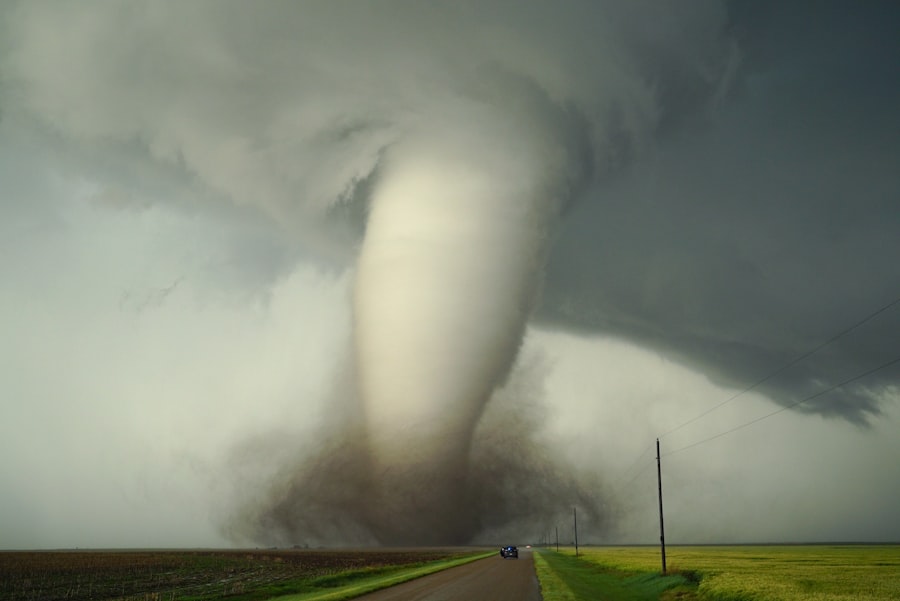Tornadoes are among nature’s most violent phenomena, characterized by their rapidly rotating columns of air that extend from thunderstorms to the ground. These powerful storms can develop with little warning, often forming in severe weather conditions where warm, moist air meets cooler, drier air. The resulting instability in the atmosphere can lead to the formation of supercell thunderstorms, which are notorious for producing tornadoes.
Understanding the conditions that foster tornado development is crucial for preparedness and safety. Tornadoes can vary significantly in size, shape, and intensity, with the Enhanced Fujita (EF) scale categorizing them from EF0, which causes minimal damage, to EF5, which can obliterate entire communities. The destructive potential of tornadoes is staggering.
They can produce winds exceeding 300 miles per hour, capable of uprooting trees, demolishing buildings, and hurling debris over great distances. The unpredictability of tornadoes adds to their danger; they can change direction suddenly and may touch down with little to no warning. This makes it essential for individuals living in tornado-prone areas to stay informed about weather conditions and to understand the signs that a tornado may be imminent.
Recognizing the characteristics of severe thunderstorms, such as dark, greenish skies, large hail, and a loud roar similar to a freight train, can provide critical seconds for seeking shelter.
Creating a Tornado Emergency Plan
Creating a Safe Shelter
Designating a safe location within the home, such as a basement or an interior room on the lowest floor, is essential. This designated area should be free of windows and equipped with necessary supplies.
Establishing Communication Protocols
In the event of a tornado, it may be difficult to use phones or other devices due to power outages or network congestion. Therefore, having a predetermined meeting place outside the home can help family members reunite after the storm passes. It is also advisable to keep a list of emergency contacts and important information readily accessible.
Practicing the Emergency Plan
Regularly reviewing and practicing the emergency plan can help ensure that everyone knows what to do when a tornado strikes. Families should discuss their plan together, ensuring that everyone understands the steps to take and where to go for safety.
Building a Tornado Emergency Kit

An effective tornado emergency kit is an essential component of any preparedness plan. This kit should contain supplies that can sustain individuals and families for at least 72 hours following a tornado. Key items to include are non-perishable food items, bottled water, a flashlight with extra batteries, a first aid kit, and any necessary medications.
Additionally, personal hygiene items and important documents should be stored in a waterproof container within the kit. Beyond basic supplies, it is wise to include tools and equipment that may be needed after a tornado has passed. A multi-tool or Swiss Army knife can be invaluable for various tasks, while a whistle can help signal for help if individuals become trapped.
A battery-powered or hand-crank weather radio is crucial for receiving updates on weather conditions and emergency information when power is lost. Regularly checking and updating the emergency kit ensures that all items are in good condition and that food and medications have not expired.
Identifying Safe Shelter Locations
| Location | Distance from nearest hospital | Capacity | Accessibility |
|---|---|---|---|
| Downtown area | 1 mile | 100 people | Accessible by public transportation |
| Suburban community | 2 miles | 50 people | Accessible by car |
| Rural area | 5 miles | 30 people | Accessible by foot or car |
Identifying safe shelter locations is a critical step in tornado preparedness. The safest place during a tornado is typically an underground shelter or basement; however, not all homes have these features. For those without basements, interior rooms on the lowest floor—such as bathrooms or closets—can provide adequate protection from flying debris and high winds.
It is important to avoid windows and exterior walls during a tornado, as these areas are more susceptible to damage. In addition to home shelters, individuals should also consider community resources. Many towns have designated storm shelters that are built specifically to withstand severe weather conditions.
Knowing the location of these shelters ahead of time can provide peace of mind and an alternative option if home conditions become unsafe. It is advisable for families to visit these shelters beforehand to familiarize themselves with the layout and procedures in place.
Monitoring Tornado Warnings and Alerts
Staying informed about weather conditions is crucial for tornado preparedness. Individuals should utilize multiple sources for weather updates, including local news stations, weather apps on smartphones, and NOAA Weather Radio broadcasts. These resources provide timely alerts about severe weather watches and warnings in the area.
A watch indicates that conditions are favorable for tornado development, while a warning means that a tornado has been sighted or indicated by radar. In addition to traditional media sources, social media platforms can also serve as valuable tools for receiving real-time updates from local meteorologists and emergency management agencies. Many communities have dedicated social media accounts that provide alerts and safety information during severe weather events.
By staying vigilant and monitoring these channels, individuals can ensure they are prepared to act quickly when a tornado threat arises.
Securing Your Home and Property

Securing one’s home and property is an important aspect of tornado preparedness that can mitigate damage during severe weather events. Homeowners should assess their property for potential hazards that could become projectiles in high winds. This includes securing outdoor furniture, grills, and other loose items that could be blown away or cause injury during a tornado.
Additionally, trimming trees and removing dead branches can reduce the risk of falling debris. Reinforcing the structure of the home itself can also enhance safety during a tornado. Installing storm shutters or impact-resistant windows can protect against flying debris.
For those living in areas prone to severe storms, investing in a safe room or reinforced basement can provide an additional layer of protection. These measures not only safeguard lives but also help minimize property damage during extreme weather events.
Staying Informed During a Tornado
During a tornado event, staying informed is paramount for ensuring safety. As conditions change rapidly, individuals must remain alert to updates from reliable sources. Keeping a battery-powered weather radio nearby allows individuals to receive continuous updates even if power goes out.
Additionally, mobile devices should be charged beforehand so that alerts can be received through apps or text notifications. It is also important for individuals in affected areas to communicate with neighbors and family members about their safety status during a tornado event. Establishing a group chat or using social media platforms can facilitate quick communication about conditions and any necessary evacuations or sheltering needs.
By staying connected and informed, individuals can make better decisions regarding their safety during severe weather.
After the Tornado: Safety and Recovery Measures
Once the tornado has passed, it is crucial to prioritize safety before assessing damage or beginning recovery efforts. Individuals should remain cautious as they exit their shelters; hazards such as downed power lines, sharp debris, and unstable structures may pose significant risks. Wearing sturdy shoes and protective clothing can help prevent injuries while navigating through debris-laden areas.
In the aftermath of a tornado, recovery efforts may begin with assessing property damage and contacting emergency services if necessary. It is advisable to document any damage with photographs for insurance purposes while avoiding entering severely damaged buildings until they have been deemed safe by professionals. Community resources may be available to assist with recovery efforts; local organizations often mobilize volunteers to help those affected by disasters rebuild their lives.
In conclusion, understanding tornadoes and preparing for them involves multiple steps that encompass education, planning, and proactive measures. By creating an emergency plan, building an emergency kit, identifying safe shelter locations, monitoring alerts, securing property, staying informed during events, and knowing how to respond after a tornado strikes, individuals can significantly enhance their safety and resilience in the face of these powerful storms.
If you are looking for more information on tornado preparedness, you may want to check out the article on storm chasing equipment and safety tips on tornadoextreme.com. This article provides valuable insights into the tools and precautions needed for storm chasing, which can also be useful for individuals looking to stay safe during tornado season. Understanding how to properly equip yourself and stay safe during extreme weather events is crucial for tornado preparedness.

